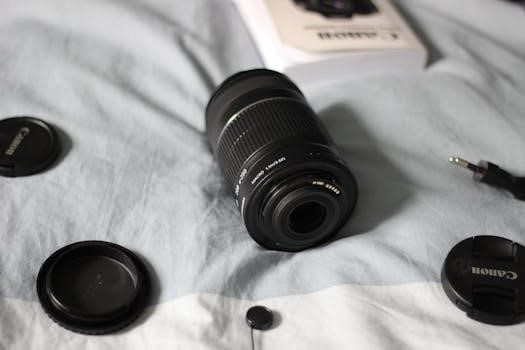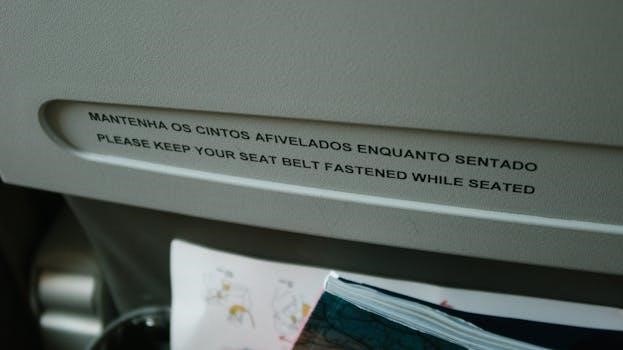canon a1 instruction manual

Canon A-1 Instruction Manual Overview
The Canon A-1 is a versatile 35mm SLR film camera that offers a range of automatic and manual shooting options. This overview will guide you through the key aspects covered in the instruction manual. Understanding the camera’s functions and controls is essential for optimal use, from basic operation to advanced techniques.

The Canon A-1, a celebrated 35mm single-lens reflex (SLR) film camera, was produced from 1978 to 1985. This model is known for its advanced features and versatility, appealing to both amateur and professional photographers; It boasts a robust build and a user-friendly design, making it a popular choice among film enthusiasts. The A-1 introduced several innovative technologies for its time, including electronic controls and multiple automatic exposure modes. It is compatible with Canon FD lenses, offering a wide selection of optics. The camera’s ability to switch between fully automatic and manual operation gives photographers significant creative control. Its enduring popularity is a testament to its quality and the timeless appeal of film photography. The A-1’s manual is an important resource for mastering its many functions and features. Exploring the manual will unlock the full potential of this classic camera, allowing for a more rewarding experience. Learning about the A-1 will not only enhance photographic skills but also offer a deep appreciation for the craft of film photography.
Key Features and Functions
The Canon A-1 is packed with features that make it a powerful tool for photography. It offers multiple automatic exposure modes, including Program AE, Shutter-priority AE, and Aperture-priority AE, allowing for easy shooting in various conditions. The camera also supports fully manual control for photographers who prefer complete command over settings. It has a built-in light meter for accurate exposure readings, and a dedicated flash hot shoe for use with Canon Speedlites. The A-1 features a clear and informative viewfinder, displaying essential shooting data. The camera’s electronically controlled shutter provides a wide range of shutter speeds, from 30 seconds to 1/1000th of a second, along with bulb mode for long exposures. A self-timer function is also included for added convenience. The A-1’s compatibility with Canon FD lenses expands creative possibilities. Understanding these key features and functions is important for any photographer looking to take full advantage of the camera’s capabilities. Detailed instructions on each of these functions can be found within the A-1’s instruction manual, providing invaluable guidance for both novices and experienced users. The camera’s numerous adjustments allow for precise image capture.
Understanding Camera Controls
Mastering the Canon A-1 involves understanding its various controls, including the mode dial, shutter speed and aperture settings, and manual mode operation. These elements work together to enable creative and technically sound photography.
Mode Dial Settings
The Canon A-1’s mode dial is central to selecting the camera’s operational mode. It offers a range of settings that cater to different shooting scenarios and user preferences. The ‘TV’ mode allows you to set the shutter speed while the camera automatically selects the corresponding aperture, useful for controlling motion blur. The ‘AV’ mode does the opposite, allowing you to set the aperture while the camera selects the shutter speed, ideal for controlling depth of field. The ‘P’ mode is the programmed automatic exposure mode, where the camera selects both the shutter speed and aperture for optimal exposure. Then there’s the fully manual mode ‘M’, giving you complete control over both shutter speed and aperture for specific creative effects. The ‘A’ setting enables aperture-priority AE, where the user selects the aperture and the camera sets the shutter speed. Finally, the ‘L’ setting locks the exposure for a specific shot, and a self-timer can be set with the ‘Self’ option. Each setting is designed to provide photographers with flexibility in different situations, making the A-1 versatile.
Shutter Speed and Aperture Adjustment
The Canon A-1 provides precise control over shutter speed and aperture, crucial for achieving desired photographic results. Shutter speed, adjusted via a dial on the top right of the camera, determines the duration the camera’s shutter remains open, influencing motion blur and exposure. Faster speeds freeze motion, while slower speeds create blur. Aperture, controlled by a ring on the lens, regulates the size of the lens opening, impacting depth of field and the amount of light entering the camera. Wider apertures (smaller f-numbers) create a shallow depth of field and are ideal for portraits, while smaller apertures (larger f-numbers) offer greater depth, suitable for landscapes. In manual mode, both settings are independently adjustable, providing full creative control, and in other modes, such as aperture-priority (Av) or shutter-priority (Tv), one setting is adjusted by the user while the camera automatically adjusts the other, ensuring correct exposure. Mastering the interaction between these settings is key to taking well-exposed and creative photographs.
Manual Mode Operation
The Canon A-1’s manual mode (M) offers complete control over exposure settings, allowing photographers to fine-tune both shutter speed and aperture independently. To engage manual mode, set the mode dial to “Tv” and then adjust the aperture ring on the lens away from “A” to a specific f-number and select a shutter speed. This mode is essential for complex lighting situations or when aiming for specific creative effects beyond automatic settings. In manual mode, the camera’s internal light meter provides a guide for proper exposure, and the user adjusts settings until the needle or LEDs are aligned, indicating correct exposure. Unlike automatic modes where the camera makes exposure decisions, manual mode empowers the photographer to choose both the light sensitivity and the depth of field, resulting in a completely personalized image. Mastery of manual mode is key to unlocking the full potential of the Canon A-1, offering a deeper understanding of photographic principles.

Using the Canon A-1
This section details the practical aspects of using the Canon A-1. It includes instructions for loading film, rewinding, setting exposure compensation, and using dedicated flash units for optimal photographic results.
Film Loading and Rewinding
To begin using your Canon A-1, you must first load the film correctly. Open the camera back by pulling up the rewind knob. Insert your chosen 35mm film cassette into the film chamber on the left-hand side, pushing it down firmly. Pull the film leader across the camera body and insert it into one of the take-up spools. Ensure the film perforations are correctly engaged with the sprocket teeth. Advance the film twice using the film advance lever, and check that the film is moving correctly. Close the camera back. Advance the film until the frame counter shows “1”. Your camera is now ready to take pictures. After completing all exposures on the roll, rewind the film by pressing the rewind button located at the base of the camera. Crank the rewind knob clockwise until you feel no tension, indicating the film is completely back in the cassette. Open the camera back and remove the exposed film. Remember to always rewind the film fully before opening the camera back to avoid light damage to your pictures.
Exposure Compensation
The Canon A-1 features an exposure compensation dial, which allows you to adjust the camera’s automatic exposure settings. This is especially useful in situations where the camera’s meter might be fooled by unusually bright or dark scenes. The exposure compensation dial is usually found near the shutter speed dial. To use it, simply rotate the dial to the desired setting. A setting of “+1” will overexpose the image by one stop, resulting in a brighter photo, while a setting of “-1” will underexpose the image by one stop, creating a darker photo. The dial is typically marked in 1/3 or 1/2 stop increments. If you are shooting in a bright environment like snow or a beach, you may need to compensate to avoid underexposure. Conversely, if you are shooting in a dark environment, you may need to compensate to avoid overexposure. Experiment with different settings to learn how to get the best results in various conditions. Remember to reset the compensation dial back to “0” when not needed.
Flash Photography with Dedicated Units
The Canon A-1 is compatible with a range of dedicated flash units, such as the Canon Speedlite 244T, 255T, and 277T, which offer automatic exposure control when used with the camera. These dedicated flashes integrate seamlessly with the A-1’s metering system, providing accurate flash exposures. When using a dedicated flash, ensure it’s properly attached to the hot shoe. The camera automatically sets the correct shutter speed and aperture for flash synchronization. Some dedicated flash units also offer features like TTL (Through-the-Lens) metering, which measures the light reflected from the subject through the lens, ensuring precise flash exposure. Additionally, these units often have their own controls for adjusting flash power, allowing you to fine-tune lighting. For optimal results, consult the flash unit’s manual for specific instructions. When shooting with flash, remember that the flash’s effective range is limited, and you should adjust the flash power to match the distance of your subject. Experiment with different flash settings to understand how they affect the final image.

Additional Resources
To further your understanding of the Canon A-1, explore online manuals and PDF downloads. Also, consider watching instructional videos and tutorials for visual guidance, enhancing your learning process. These resources offer valuable insights and practical tips.

Online Manuals and PDF Downloads
Accessing online resources for the Canon A-1 instruction manual is a convenient way to learn about your camera. Many websites offer free PDF downloads of the original manual, allowing you to have a digital copy available on your computer or mobile device. These digital manuals often include searchable text, making it easier to find specific information quickly. Some websites may also host translated versions of the manual, catering to a broader audience. Furthermore, online forums and communities dedicated to vintage cameras frequently provide links to these resources, and users often share their own scanned versions of manuals in case the original PDF is hard to find. Having a digital manual allows you to easily zoom in on diagrams and illustrations, which can be very helpful when trying to understand more complicated features of the Canon A-1. Keep in mind that some user-submitted versions may vary slightly in quality, so try to find the most official and clear scan available for best results. The availability of these online resources significantly contributes to the ease of maintaining and understanding your Canon A-1.
Instructional Videos and Tutorials
Beyond written manuals, instructional videos and tutorials offer a dynamic way to learn about the Canon A-1. Platforms like YouTube host numerous videos demonstrating the camera’s features and functions. These visual guides can be especially helpful for understanding complex procedures like film loading, exposure settings, and using various shooting modes. Many videos are created by experienced photographers who share tips and tricks for getting the most out of the camera. Tutorials often cover specific topics, allowing you to focus on the areas you need help with. Some videos also include real-world shooting examples, giving you a sense of the camera’s capabilities. When searching for videos, look for those with clear audio and visuals, and check the creator’s credibility. Some tutorials might be focused on specific aspects of the camera that you may need, such as manual mode, or flash usage, or even basic troubleshooting steps. These videos, combined with the written manual, make it easier to get the most out of your Canon A-1 and can help both novice and experienced users.